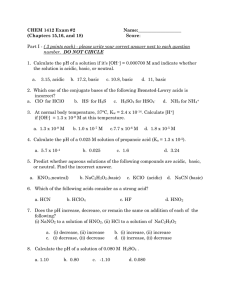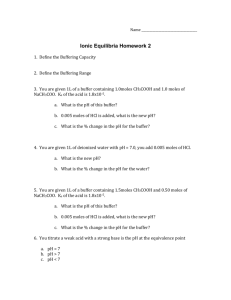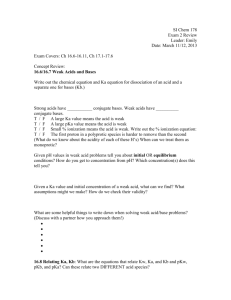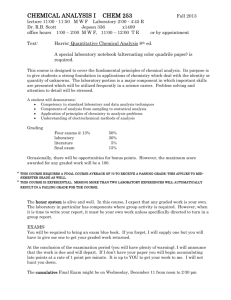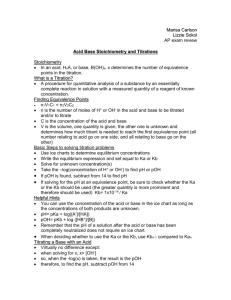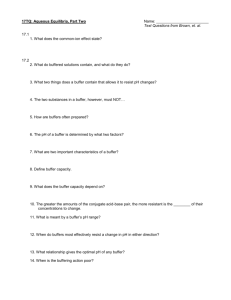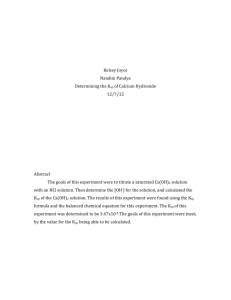Exam 2 Practice Test Solutions
advertisement
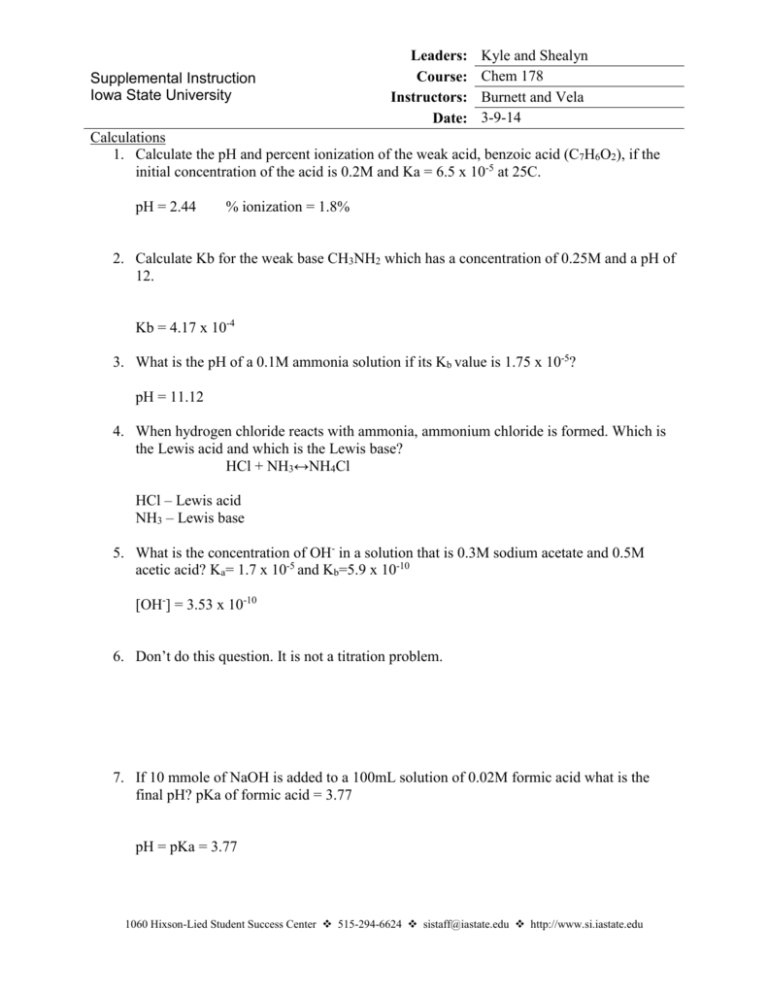
Supplemental Instruction Iowa State University Leaders: Course: Instructors: Date: Kyle and Shealyn Chem 178 Burnett and Vela 3-9-14 Calculations 1. Calculate the pH and percent ionization of the weak acid, benzoic acid (C7H6O2), if the initial concentration of the acid is 0.2M and Ka = 6.5 x 10-5 at 25C. pH = 2.44 % ionization = 1.8% 2. Calculate Kb for the weak base CH3NH2 which has a concentration of 0.25M and a pH of 12. Kb = 4.17 x 10-4 3. What is the pH of a 0.1M ammonia solution if its Kb value is 1.75 x 10-5? pH = 11.12 4. When hydrogen chloride reacts with ammonia, ammonium chloride is formed. Which is the Lewis acid and which is the Lewis base? HCl + NH3↔NH4Cl HCl – Lewis acid NH3 – Lewis base 5. What is the concentration of OH- in a solution that is 0.3M sodium acetate and 0.5M acetic acid? Ka= 1.7 x 10-5 and Kb=5.9 x 10-10 [OH-] = 3.53 x 10-10 6. Don’t do this question. It is not a titration problem. 7. If 10 mmole of NaOH is added to a 100mL solution of 0.02M formic acid what is the final pH? pKa of formic acid = 3.77 pH = pKa = 3.77 1060 Hixson-Lied Student Success Center 515-294-6624 sistaff@iastate.edu http://www.si.iastate.edu 8. Using the following titration of 0.050 L of a 0.100 M HBr acid solution using 0.250 M NaOH. a. What is the pH before the titration begins? pH = 1 b. What is the pH after 50.00 mL of NaOH is added? pH = 12.88 9. In a solution of 0.200M NaI, solid AgI was placed in. Calculate the molar solubility of AgI (Ksp = 1.5 x 10-16) 7.5 x 10-16 M 10. Solid barium phosphate dissolves into its ions at room temp. If [Ba2+] = 1.5 x 10-2 M at equilibrium find the value of Ksp. Ksp = 3.4 x 10-10 11. Calculate the Ksp of Ag2S if the solution contains [S2-] = 2.92 x 10-17 at equilibrium. Ksp = 9.96 x 10-50 12. Calculate the solubility of Zn(OH)2 in mg/L. Ksp = 4.5 x 10-17 0.22 mg/L 13. Calculate the concentration of an aqueous solution of Ca(OH)2 that has a pH of 10.05 5.61 x 10-5 M 14. The pH of a 0.100 M solution of formic acid, HCOOH, at 25 degrees Celsius is 2.38. Calculate Ka for formic acid at this temperature. Ka = 1.8 x 10-4 15. What is the pH of a 0.300 M solution of methylamine? (Kb = 4.4x10-4) pH = 12.06 16. Will the following solutions be acidic, basic or neutral? a. Ba(CH3COO)2 basic b. NH4Cl acidic c. Al(ClO4) acidic d. NaCl neutral 17. Arrange the compounds in order of increasing acid strength: a. AsH3, HBr, KH, H2Se KH, AsH3, H2Se, HBr b. H2SO4, H2SeO3, H2SeO4 H2SeO3, H2SeO4, H2SO4 18. Circle the stronger acid: a. a. HClO3 HClO4 b. b. HBr HF c. c. PH3 H2S d. d. HNO3 HNO2 19. What is the pH of a 1L solution made by adding 0.4 mol of acetic acid and 0.3 mol of sodium acetate to water? pH = 4.62 20. What is the percent ionization of 0.0075M butanoic acid in a solution containing 0.085M sodium butanoate? 0.2 % 21. You are asked to prepare a pH = 3.00 buffer solution starting from 1.25L of 1.00M HF solution, and excess NaF. How many grams of NaF should be added to prepare the buffer? 35.6 grams (challenging question!) 22. What is the pH of the buffer if 85 mL of 0.13M lactic acid and 95 mL of 0.15M sodium lactate are mixed? pH = 3.96 23. Calculate the pH of the solution formed when 45 mL of 0.100M NaOH is added to 50 mL of 0.100M CH3COOH (Ka = 1.8 x 10-5) pH = 5.70 24. Write the expression for the solubility-product constant for the following: a. SrSO4 Ksp = [Sr2+][SO42-] b. Fe(OH)2 Ksp = [Fe2+][OH-]2 25. The Ksp value for LaF3 is 2 x 10-19. What is the solubility of LaF3 in water in moles per liter? 9.28 x 10-6 M 26. How much 2M HCl must be added to 150mL of 0.3M ammonia in order to reach equivalence? What is the volume of the solution at equivalence? 22.5 mL, 172.5 mL Concepts 27. How does the strength of the H-X bond affect acid strength? The weaker the bond, the stronger the acid. 28. There are two reasons for an oxyacid’s strength to increase what are they? a. large electronegativity on the central atom b. large electronegativity of the ligands, more O’s bonded to central atom 29. What must a Lewis base have? A lone pair of electrons to donate 30. What is the common ion effect? The reduction in the solubility of a solution when a soluble compound containing one of the ions (a common ion) in the solution is added to the solution in equilibrium. 31. What is a buffer solution? Describe what it does and what its components are. A solution the resists a large change in pH. It is made of a weak acid and its conjugate base or a weak base and its conjugate acid. It resists pH change by allowing added H+ to react with a conjugate base and make more weak acid or by allowing added OH- to react with a conjugate acid and make more weak base. 32. What is buffer capacity? The maximum amount of OH- or H+ that can be added before a large change in pH occurs. 33. What two changes of a transition metal will cause its Ka value to increase? a. increase in the charge on the metal b. decrease in the radius size of the metal 34. Does the strength of the acid or base determine the volume of titrant to reach the equivalence point? If not what does? No it does not depend on the strength of the acid or base. The volume to reach equivalence only depends on the concentration/molarity of the acid or base. 35. In the titration of the weak polyprotic acid H3PO4 and a strong base it takes 15mL to remove the first H+. What volumes will remove the second and third H+? The same volume of strong base will be required to remove each successive hydrogen, 30mL for the second, 45 mL for the third will be the total added volume. 36. Sketch a graph of what this titration would look like. Label the axes, equivalence points, buffer zones (with the buffer components), and the equivalence volumes. The midpoints in this graph are the buffer regions and are composed of the weak acid present and its conjugate base. Notice that the equivalence point volumes are all the same volume. No, this graph does not reflect the previous problem, but it is still an accurate polyprotic acid titration curve. 37. How does the titration curve of a strong acid and strong base differ from a weak acid and a strong base? Strong acid and strong base Weak acid and strong base 38. Acetic acid is mixed with enough NaOH to reach equivalence. How would the amount of base needed to reach equivalence change if HCl was used instead of acetic acid? *for this problem assume the same concentration for both the weak and strong acids. The same volume of base with be required to reach equivalence with both the acids. 39. Is a compound with a pKa of 5.1 more acidic or less acidic than a compound with a pKa of 8? The pKa of 5.1 is more acidic 40. Given that the Ka value for acetic acid is 1.8 x 10-5 what is the pKb value for the acetate ion? Kb = Kw/Ka pKb = -log (Kb) 9.26 41. Why are carboxylic acids acidic? Because they have resonance structures 42. What are an acid and a base according to each definition? a. Arrhenius: A: increase H+ in H20; B: increase OH- in H20 b. Bronsted-Lowry: A: donates H+; B: accepts H+ c. Lewis: A: accepts a lone pair of electrons; B: donates a lone pair of electrons 43. What does Ksp stand for? If the Ksp value of a salt is large what does that mean for the salt? It is the solubility product constant. If a salt has a large Ksp value it means that the salt is soluble to very soluble.

